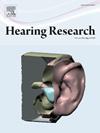Investigation of bone conduction stimulation efficiency on the skull surface and below assessed by cochlear promontory vibration
IF 2.5
2区 医学
Q1 AUDIOLOGY & SPEECH-LANGUAGE PATHOLOGY
引用次数: 0
Abstract
Objective
Stimulation sites closer to the cochlea result in higher output for bone conduction devices (BCD), increasing maximum output and reducing energy consumption. In our study, alternative coupling sites closer to the ear canal (EC), in cortical and spongious bone, were investigated and the influence on ipsi- and contralateral bone conduction output was quantified.
Methods
Cochlear promontory (CP) vibrations were measured by 1D laser Doppler vibrometry, using five freshly frozen (10 ears) whole human cadaver heads. A percutaneous actuator was implanted at different positions: five on the surface 25 to 55 mm posterior to the EC and two recessed positions 20 mm posterior to the EC at 5 to 8 mm depth. Stimulation was performed using a stepped sine, consisting of 78 frequencies from 0.1 to 10 kHz.
Results
In comparison to positions 50–55 mm to the EC, average CP vibrations showed significantly increased CP vibrations, ranging from 6.5 dB to 13.9 dB between 0.5 and 4 kHz at closer and recessed positions. In contrast, contralateral results showed smaller output amplitudes (0.5 kHz < f < 4 kHz). For positions closer to the EC, transcranial attenuation was considerably increased up to 25.2 dB at 4 kHz.
Conclusion
Our results show a significant increase of CP vibrations in stimulation direction, for positions closer to the cochlea. Moreover, the feasibility of bone anchors in spongious bone was demonstrated, leading to similar output when compared to positions on the skull surface.
耳蜗峡部振动评价颅骨表面及以下骨传导刺激效率的研究
目的:靠近耳蜗的刺激部位可提高骨传导装置(BCD)的输出功率,提高最大输出功率,降低能量消耗。在我们的研究中,研究了皮质骨和海绵状骨中靠近耳道(EC)的其他偶联位点,并量化了对单侧和对侧骨传导输出的影响。方法用5个新鲜冷冻(10耳)全人头颅,采用一维激光多普勒振动仪测量耳蜗角(CP)振动。在不同的位置植入一个经皮致动器:5个在EC后25至55毫米的表面,2个在EC后20毫米的5至8毫米深度的凹陷位置。采用步进正弦进行刺激,包括从0.1到10khz的78个频率。结果与距离EC 50 ~ 55 mm位置相比,在0.5 ~ 4 kHz范围内,较近位置和凹陷位置的平均CP振动显著增加,振动范围为6.5 ~ 13.9 dB。相反,对侧结果显示较小的输出振幅(0.5 kHz <;f & lt;4 kHz)。对于靠近EC的位置,经颅衰减显著增加,在4 kHz时可达25.2 dB。结论靠近耳蜗的位置在刺激方向上CP振动显著增加。此外,研究还证明了在海绵状骨中使用骨锚的可行性,与在颅骨表面的位置相比,其输出结果相似。
本文章由计算机程序翻译,如有差异,请以英文原文为准。
求助全文
约1分钟内获得全文
求助全文
来源期刊

Hearing Research
医学-耳鼻喉科学
CiteScore
5.30
自引率
14.30%
发文量
163
审稿时长
75 days
期刊介绍:
The aim of the journal is to provide a forum for papers concerned with basic peripheral and central auditory mechanisms. Emphasis is on experimental and clinical studies, but theoretical and methodological papers will also be considered. The journal publishes original research papers, review and mini- review articles, rapid communications, method/protocol and perspective articles.
Papers submitted should deal with auditory anatomy, physiology, psychophysics, imaging, modeling and behavioural studies in animals and humans, as well as hearing aids and cochlear implants. Papers dealing with the vestibular system are also considered for publication. Papers on comparative aspects of hearing and on effects of drugs and environmental contaminants on hearing function will also be considered. Clinical papers will be accepted when they contribute to the understanding of normal and pathological hearing functions.
 求助内容:
求助内容: 应助结果提醒方式:
应助结果提醒方式:


